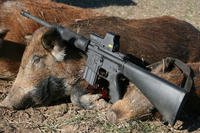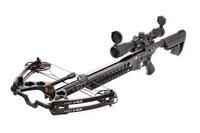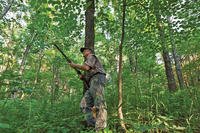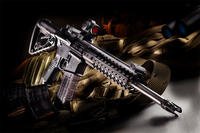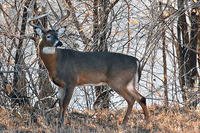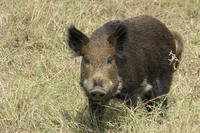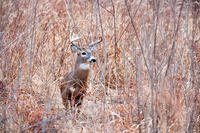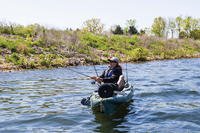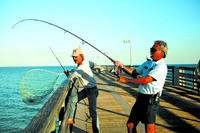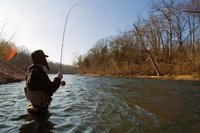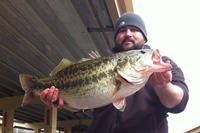If it's Mardi Gras time, it must be Sheepshead time.
by Ed Mashburn
Let the good times roll! Early spring in the Gulf Coast area is a time for parties, parades, and good eating- in other words, Mardi Gras. However, the festivities also coincide with the annual sheepshead run — which gather in the bays and river passes for their own fishy fun and games. This time of year anglers have the best shot at catching a mess of these hard-fighting, super-quick biting, and sometimes totally frustrating inshore gamefish. The sheepshead actually looks like something which would fit in well at a Mardi Gras parade- bold black and white stripes, large prominent dorsal fins, and grotesque looking buck teeth would be right at home catching or throwing Mardi Gras beads and moonpies.
Although the sheepshead looks somewhat clownish, many anglers will swear that these fish can make the sharpest and quickest of us look foolish when they’re in a “nibbling” mood. The reputation of sheepshead among anglers is one of flat-out thievery- they are widely regarded as the best bait-stealers that swim. Their habit of simply mouthing the bait until the hook is bare while giving no indication of a bite to the angler above is legendary. However, with a little planning and attention to equipment and technique, sheepshead can be caught in impressive numbers. Even though this fish tends to bite gently, they fight hard all the way in. It’s common to catch Sheepshead in the 7 to 8 pound category, and sometimes up to 10 pounds, so these funny-looking fish can put some serious strain on an angler and gear.
Although sheepshead are present in coastal Gulf waters year-round, they tend to be very scattered and hard to catch the remainder of the year. However, they spawn in large numbers during the early spring, and this concentrates the fish. By being at the right place at the right time, anglers can take advantage of the striped bait-stealers’ need to load up with lots of protein and fat for spawning.
Gear Up for Sheepshead
One of the best things about sheepshead fishing is that it doesn’t require super-specialized gear. I prefer a six- to seven-foot-long spinning rod — graphite is nice because it detects the gentle bites well. This rod should handle 12- to 15-pound-test line. I like spinning gear, but baitcasting reels work fine, too. Whatever type of reel is used, it must have a good drag system. When a 10-pound sheepshead takes the bait and decides to go the other way, the reel’s drag can’t stick. Since most sheepshead fishing doesn’t require long casts, anglers can usually choose equipment, which fits their hands well and is comfortable.
The lighter the line, the better when trying to detect the nibbles. However, 8-pound-test line or less, is hardly a match if a big redfish take the bait. Twelve-pound-test line is a good compromise. Another good choice is abrasion-resistant braided line. Sheepsheads live near cover, which is usually encrusted with razor-sharp barnacles. The striped fish seem to know that barnacles and oyster shells will lose an angler quickly when the fish takes a turn around a piling or rock.
I like a three-foot piece of 20-pound-test fluorocarbon for a leader, and I prefer a No. 4 Kahle hook. Kahle hooks have a wide gap which really bites into the fish and holds strong. Some anglers swear by a small treble hook and I’ve seen this work well on occasion. Any hook used for sheepshead must be strong due to its crushing teeth. Anglers should use stout, salt-water hooks.
For weight, I put a split shot about a foot above the hook and a sliding egg-sinker above that. Because of varying current strength, some days I use as little as ¼ ounce sinker and some days I go as heavy as 1 ounce. If it takes much more than an ounce to get the bait to the bottom, I usually can’t feel the subtle bite. The key with weight, as it is with line, is to go as light as possible under conditions. Lighter gear makes it much easier to detect the bites.
Live Bait is a Must
Although some anglers catch sheepshead on artificial baits, it can be hit or miss. Most anglers rely on live bait — the fresher the better, too.
The standard bait for sheepshead is shrimp. If a choice is given when buying shrimp, don’t buy the large shrimp. Shrimp about 2 inches long are perfect. Sheepshead will eat the large ones, but will nip and bite the bigger ones off the hook easier than the smaller ones. Hook the shrimp right under the nose-horn, but sometimes when the sheepies are being very clever in removing the bait from the hook, I will run the hook up through the tail section. When the bait is being bitten but all that comes in with the hook is the shell of the head. Sheepshead will surgically remove the good parts of the shrimp and leave the tough head behind. Keep sending shrimp down- the fish will make a mistake before long.
Great bait for sheepshead is live fiddler crab about the size of a 50-cent piece. Sheepshead will really hammer these crabs. Fish the crabs just like shrimp. Run the point of the hook up from the belly and out through the side of the crab below a leg — make sure the point of the hook is clear of the crab’s shell. Fiddlers aren’t as easy to find at baitshops as shrimp, but when available, they are certainly worth a try.
Bait that requires a little more work for fisherman is oysters. Sheepshead love oysters, but they’re very hard to use as bait because a raw oyster will just not stay on a hook at all. To remedy this, cut a piece of pantyhose into a 2-inch square and put the raw oyster in the middle. Then, wrap the oyster up and tie the edges with twine or light line. Finally, put the wrapped oyster on the hook and go fishing. It sounds silly and might be hard to explain to your wife but it works.
How and Where- Tips for Sheepshead Success
Just as in Real Estate, when fishing for sheepshead, the key for success is location. Since sheepshead are totally structure-oriented, anglers should investigate bridge pilings, rock jetties, dock pilings, oyster bars, old wrecks and storm debris near Gulf Coast passes. Water from five to 15 feet deep is good.
While this may seem an easy way to locate fish, it’s not. For whatever reason, sheepshead might absolutely cover a certain bridge piling or rock, and the next piling or rock might not have fish. Sheepshead can be caught from shore or in a boat. Perdido Pass, Alabama; Fort Pickens in Pensacola Pass; and the bridge over Destin Pass in Florida are all classic northern Gulf Coast land-based locations for sheepshead fishing.
Anglers fishing from boats can find rocks and other debris that shorebound anglers can’t reach. When moving along bridges, jetties and other above-surface structure, anglers should keep an eye on the fish finder. Big rocks and other bottom structure hidden below the surface near visible above-water structure can hold some really big sheepshead which escape detection by many anglers. Fish these “secret” structures and be prepared for some hot action.
An example of how tricky sheepshead can be happened to me a couple of years ago at Perdido Pass. A long rock jetty juts into the Gulf at Perdido Pass, and sheepsheads are thick on this jetty in the spring. I, along with about fifty other eager anglers, were working this jetty with live shrimp. A good tide was coming in, and in the clear Gulf water, we could actually see the black and white sheepshead swimming close to the rocks. It looked like a set-up. I fished that jetty hard and caught nothing but rocks. Only one other angler, an older gentleman using a cane pole and shrimp, was catching them. For whatever reason, the rock he was fishing held fish that wanted to bite, and the other rocks held none. While this old fellow filled up a five-gallon bucket, the rest of us got to watch.
Sheepsheads are creatures of habit. A good point for anglers to keep in mind is that good sheepshead structure will hold fish year after year. Anglers should remember what rock, piling or dock held fish, because sheepshead will probably be on that structure next year.
The best way to fish for sheepshead is vertically. If the bait can be dropped directly down the side of a piling or post to the depth that the fish are holding, the line will be tighter and easier to “read” as opposed to a lateral cast which has more slack. When fishing a post or pilings, try to let the bait to the bottom slowly. Watch the line! If it so much as twitches, set the hook. Sheepshead will often take a live bait as it drops toward the bottom. When the bait reaches bottom, let it sit. If no strike occurs within a fairly short period of time, slowly retrieve the bait back up the piling. Sheepshead don’t usually like to chase down the bait. If the bait is neither being stolen nor fish being caught, then relocate fairly soon. Sheepsheads aren’t shy about biting, and if nothing is happening, then the fish aren’t there.
The best place to fish for sheepsheads is right next to the cover. If you’re not getting snagged occasionally, then you’re not fishing close enough to the cover. You will go through a lot of hooks, sinkers, leaders and line. It’s just an occupational hazard — be sure and bring lots of replacement gear.
Some Other Concerns
Anglers should exercise caution when removing a sheepshead from the hook. First, you’ll notice its large incisor teeth. Keep fingers away from these. Anything, which makes its living biting and crushing barnacles and oysters, should be treated with respect. You’ll also notice their large, sharp dorsal fins. These fins really hurt when they find a careless hand — this I know from experience.
Sheepshead are difficult to clean, too. Their scales are thick and tough, and their bone structure makes filleting them somewhat different from most fish. Don’t attempt to clean them without a quality electric knife with a sharp set of blades.
The last thing that the lucky angler who harvests a good mess of these striped bait-stealers will notice is how well the fillets cook up. I love to eat fish of all kinds, but sheepshead is right at the top of my list of favorite eating fish. No matter how they’re prepared, sheepsheads are delicious. The firm fillets freeze nicely for future cooking, too.
There’s no doubt about it. Early spring is a fine time to party down at Mardi Gras parades and parties, but for the angler it’s a great time to get on the water in search of the funny-looking, hard-fighting, and delicious-tasting striped fish. Let the Good Times Roll!
The Facts of Life for Sheepshead
Sheepshead gather in massive schools in the early spring to spawn. This activity requires lots of energy, so the fish feed constantly and become much more susceptible to anglers.
Dr. Bob Shipp, Chair and Professor, Department of Marine Sciences of the University of South Alabama, says that sheepshead spawn offshore in open water where their fertilized eggs hatch. Then the larval fish move into the estuaries and rivers of the Gulf Coast where they grow and mature. By the way, the average mature female sheepshead will lay from 500,000 to 1,000,000 eggs each spring. After spawning, the adult fish disperse and move back into their inshore homes. The fishes lifespan is from seven to 10 years.
Dr Shipp, author of the standard reference book on Gulf fish- Guide to the Fishes of the Gulf of Mexico, says that sheepshead stocks are very good at this time.
Chum up the Sheepies
Even though sheepshead can sometimes be difficult to persuade to bite, it’s frustrating to see the black and white rascals swimming around in the clear waters totally ignoring your best offerings. However, sheepshead can be very susceptible to chumming.
Here are two proven means of chumming for sheephead: Find or buy a five-gallon bucket of undersized live oysters. These can often be found near boat ramps or mud flats. Use a short section of 2-inch by 4-foot board to crush the shells in the bucket and break the hard shell into smaller chunks. This will release the delicious oyster juices and free tiny pieces of raw oyster. Carefully pour two handfuls of the chum upcurrent of the piling or other structure that the lock-jawed sheepsheads are on. As the broken oyster shells sink through the water, sheepshead will come to investigate and pick out the edible portions. After a few dumps of free chow, lower the baited hook and hold on.
The second chumming technique is even simpler. Put a straight-edged shovel or garden hoe in the boat before leaving home. When the boat is located near a promising structure, use the shovel or hoe to scrape barnacles and other small shell-fish off the underwater portions of the structure. As the broken and dislodged shells and soft parts of the barnacles sink downward, sheepies will eagerly line up to the free food. After a little while, drop a live shrimp or fiddler crab into the chum stream. The rod should start bending shortly.
Fishing Alabama
The author has a new book out that has just hit the shelves; Fishing Alabama – An Angler’s Guide to 50 of the State’s Prime Fishing Spots. The detailed book tells about the different waters and fish that can be caught in them. The pages are full of how-to information and images and illustrations of the fish and waters. The book retails for $16.95 and can be found by online or by contacting The Lyons Press, www.lyonspress.com.
